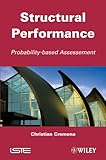Structural performance : probability-based assessement / Christian Cremona.
Material type: TextSeries: ISTEPublication details: London : ISTE ; Hoboken, NJ : Wiley, 2011.Description: 1 online resource (xiii, 429 pages) : illustrationsContent type:
TextSeries: ISTEPublication details: London : ISTE ; Hoboken, NJ : Wiley, 2011.Description: 1 online resource (xiii, 429 pages) : illustrationsContent type: - text
- computer
- online resource
- 9781118601167
- 1118601165
- 9781118601174
- 1118601173
- 9781118601150
- 1118601157
- Structural analysis (Engineering) -- Statistical methods
- Structural failures -- Risk assessment -- Statistical methods
- Structural analysis (Engineering) -- Statistical methods
- Structural failures -- Risk assessment -- Statistical methods
- TECHNOLOGY & ENGINEERING -- Industrial Health & Safety
- TECHNOLOGY & ENGINEERING -- Industrial Health & Safety
- TECHNOLOGY & ENGINEERING -- Structural
- 624.1/71 22
- TA640.2 .C84 2011eb
- TEC017000
Includes bibliographical references (pages 413-421) and index.
Print version record.
Cover; Structural Performance; Title Page; Copyright Page; Table of Contents; Preface; Chapter 1. Concepts from Probability Theory and Statistics; 1.1. The role of probability in civil engineering; 1.2. Physical and statistical uncertainties; 1.3. Axiomatics; 1.3.1. Probabilities; 1.3.2. Axioms; 1.3.3. Consequences; 1.3.4. Conditional probabilities; 1.4. Random variables -- distributions; 1.4.1. Definitions; 1.4.2. Sampling; 1.4.3. Probability density function; 1.4.4. Main descriptors of a random variable; 1.4.5. Joint variables; 1.4.6. Independent variables; 1.4.7. Correlation coefficient.
1.4.8. Functions of random variables1.4.9. Approximate moments; 1.5. Useful random variables; 1.5.1. Discrete variables; 1.5.2. Normal distribution; 1.5.3. Lognormal distribution; 1.5.4. Beta distribution; 1.5.5. Exponential distribution; 1.5.6. Gamma distribution; 1.5.7. Student's t-distribution; 1.6. Limit theorems; 1.6.1. Law of large numbers; 1.6.2. Limit theorems; 1.7. Modeling random variables; 1.7.1. Point estimation; 1.7.2. Interval estimation; 1.7.3. Estimation of fractiles; 1.7.4. Estimation of the distribution; 1.8. Distribution of extremes; 1.9. Significance testing.
1.9.1. Type I and II errors1.9.2. Usual tests; 1.10. Bayesian analysis; 1.10.1. A priori and a posteriori distributions; 1.10.2. Updating estimators; 1.10.3. Bayesian networks; 1.11. Stochastic processes; 1.11.1. Basic principles; 1.11.2. Markovian chains; 1.11.3. State probability; 1.11.4. Time between stages; Chapter 2. Structural Safety, Performance and Risk; 2.1. Introduction; 2.2. Safety and risk; 2.2.1. Concepts of safety; 2.2.2. Concept of risk related to a danger or threat; 2.2.3. Risk assessment; 2.2.4. Hazard; 2.3. Risk evaluation and acceptable risk; 2.3.1. Risk assessment.
2.3.2. Acceptable risk2.4. Risk-based management; 2.4.1. Strategies; 2.4.2. Risk analysis; 2.4.3. Legal point of view for a risk-based approach; 2.5. Examples of failure: bridges; 2.6. From safety to performance; 2.6.1. Functions of a structure; 2.6.2. Performance; 2.6.3. Evolution of structural functionality; 2.6.4. Consequences of performance losses; 2.6.5. Generalization of the concept of risk; 2.7. Human errors; Chapter 3. Performance-based Assessment; 3.1. Analysis methods and structural safety; 3.1.1. Allowable stress principle; 3.1.2. Limit states and partial factors.
3.1.3. Probability-based approach3.2. Safety and performance principles; 3.2.1. New structures; 3.2.2. Existing structures; 3.3. Invariant measures; 3.4. Reliability theory; 3.4.1. Basic problem; 3.4.2. Convolution integral; 3.4.3. Normal variables; 3.4.4. Geometric expression of the reliability index; 3.4.5. Joint distribution representation; 3.4.6. Limit state with more than two uncorrelated normal variables; 3.4.7. Limit state with correlated variables; 3.5. General formulation; 3.5.1. Failure component -- failure mode; 3.5.2. Safety margins -- limit state functions.
This book covers the development of efficient methods for the assessment and the management of civil structures is today a major challenge from economical, social and environmental aspects. Tools for handling uncertainties in loads, geometry, material properties, construction and operating conditions are nowadays essential. Covers the key concepts across topics including probability theory and statistics, structural safety, performance-based assessment, modelling uncertainties and principles of decision theory.
Computer Science and Engineering
